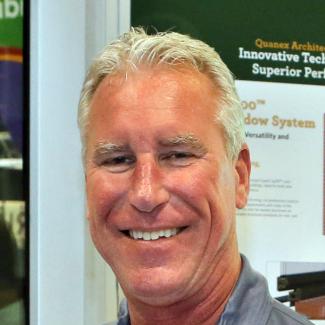Vinyl Emerges as a Viable Option in High-rises, Despite Market Hurdles
 |
|
Quanex’s Mikron 1250 vinyl window series at the AMLI apartment building in South Lake Union, Washington. |
One building solution that is gaining traction as a real, viable option in the architectural community, and as another step forward in the performance of the building envelope, is the use of vinyl windows in high-rise applications. Vinyl provides an alternative to conventional commercial systems—one that allows architects to reach their energy performance goals in a simple, cost-effective way.
PVC windows install the same as conventional commercial systems; look the same as conventional systems; are as structurally sound as conventional systems; and are comparable in price to standard conventional systems. But when it comes to performance, PVC windows are anything but the same as conventional commercial systems. Vinyl windows can achieve improved performance without resorting to exotic gases and glass packages.
Even though PVC has its merits, there are still some hurdles to overcome before it becomes more widely adopted for heavy commercial projects.
1. Perception
Right or wrong, PVC has a certain perception: “It’s cheap. It won’t perform as well. It doesn’t have the structural strength. It’s fine for residential, but not for my application.”
Overcoming these lingering perceptions is the number one barrier to vinyl’s commercial market penetration. Architects and fabricators working in light commercial applications, including low-rise and multifamily housing, have already boldly entered the new frontier. They are already enjoying the benefits of vinyl.
Architects and fabricators are achieving lower U-factors without the hassle and added costs of upgrading conventional systems just to get them close to the U-factors vinyl systems can achieve. Only now are architects seeing the merits in high-rise applications.
This gradual acceptance is the result of the vinyl industry providing education and real-world proof that it will perform as promised, even in demanding applications. Architects are listening. But that’s only the beginning, which leads to the next hurdle, getting fabricators onboard.
2. Availability
While architects are showing signs of acceptance, or even excitement, over the possibility of incorporating vinyl systems into their mid and high-rise building designs, they still must be able to get vinyl.
The sentiment from window fabricators is that architects don’t want vinyl. As a result, architects believe they can’t get it, or at least can’t get it easily. Thus, a vicious cycle of supply not matching potential demand begins. Even though perception is changing, the fact that there aren’t enough fabricators equipped to build commercial vinyl systems is proving to be a major hurdle.
Fabricators need incentive to invest in, add to and alter their plant floors and production processes. In some cases, that might mean adding a new plant. The decision to add vinyl capabilities is not one they are taking lightly.
So, at least for the time being, vinyl and its use in high-rises are hindered by a lack of availability.
However, there are fabricators who are realizing that the demand is there and are using vinyl as a point of differentiation. They are working with architects who also see that vinyl can get them the performance levels they want – and vinyl is getting the chance to prove its value in larger commercial projects.
As education continues and there are more successful installations, demand from architects will grow and savvy fabricators will diversify to meet and capitalize on that demand.
3. Time and resources
Not to belabor the issue of the skilled labor shortage in the building and construction industry, but it has to be a consideration in this discussion. Many reading this article have been impacted by the labor shortage and architects are no different.
Architects still want to push forward and advance their designs, but many are lacking the time and the resources to do everything they want to do. So while they are open to new ideas, we in the vinyl industry need to work toward making it easier for them to specify our materials so it’s less taxing on the supply chain.
From our perspective, we are seeing some positive signs. While seeing the competition entering the space and showing up at architectural events and conferences might sound like a negative, in this case having the competition around is healthy.
First, it’s evidence that vinyl has the potential to become a real player in heavy commercial applications. Second, more feet on the ground means the word will spread faster and wider, creating the demand that will help us overcome the hurdles discussed in this article.
As a collective, we must keep working to provide the tools and education necessary to turn vinyl adopters into vinyl advocates. To make it easier to specify and easier to obtain. To provide the proof architects need that it not only works, but it provides the energy performance and cost benefits they seek.
The vinyl industry must stay vigilant to make sure it overcomes these hurdles, continues to provide education and diversifies product offerings, including offering multiple colors and both CW- and AW-rated options.



